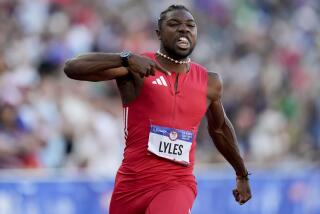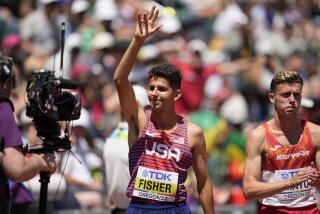Runner Settled for Less, Except on the Track
- Share via
Jeff Atkinson asked for little and settled for less. He was satisfied with a place to stay, junk-food meals and friends to train with.
As Stanford track Coach Brooks Johnson put it: “Jeff didn’t think it was his birthright to get $80 million a year just because he was a quality runner.”
Atkinson managed on less than $500 a month after he left Stanford in 1986. He shared a cramped bedroom in a Palo Alto apartment with two other runners, putting a better life on hold while he pursued the Olympic dream.
In retrospect, the self-proclaimed “late bloomer” knows that the reward was worth the sacrifice.
The hardships Atkinson endured during the last two years were overshadowed Saturday when the former Mira Costa High School standout held off two-time Olympian Steve Scott to win the 1,500-meter final at the U.S. Track and Field Trials in Indianapolis.
In front of a national television audience, Atkinson grinned and pumped his fist after crossing the finish line in 3 minutes, 40.94 seconds. At 25, he established himself as one of America’s top milers, a position he hopes to maintain through the 1992 Olympics.
Perhaps more important are the benefits that come with the territory.
Making the Olympic team figures to make it easier for Atkinson to support himself. He will be paid $1,500 a month by the U.S. Olympic Committee until the Seoul Games in September, and after that he hopes to negotiate a deal with a shoe company.
Not bad for a guy who wasn’t recruited out of high school and, upon his arrival at Stanford in 1981, was labeled an “immature Southern California beach boy” by Johnson.
Atkinson has grown up a lot since then, but he still has the beach boy in him. When he visits his family in Manhattan Beach, he makes it a point to spend time on the sand and catch a few waves.
However, it’s been his steady improvement as a runner that has given Atkinson the greatest satisfaction. He wasn’t considered a favorite at the Olympic trials, a fact that may have worked in his favor.
“I don’t think anybody outside of a few enlightened competitors were concerned about what I would do,” he said by telephone from Chicago, where he stayed with friends until leaving today for a 3-week, 5-meet tour of Europe. “That might have been to my advantage.
“Winning was a surprise, but making the team really wasn’t because I’ve been running well.”
While Atkinson took the victory in stride, others considered it a stunning upset. After all, his highest U.S. ranking in the 1,500 was fifth in 1986.
Dave Holland, who coached Atkinson at Mira Costa, was in London on Sunday accompanying a group of Mira Costa students when his wife called to tell him the good news.
“It was a major surprise,” Holland said. “Not that he hasn’t run fast before, but to finish first! I couldn’t believe it. It was one of those things where every 10 or 15 minutes I’d think about it and start laughing.”
His competitors were taken aback.
Scott told The Times: “I was aware that Jeff was coming on this year, but I didn’t think he had that extra gear. He made a major jump today.”
Scott, the premier U.S. miler for a decade, made a move with about 100 meters to go, but Atkinson held his ground on the inside.
“We were coming out of the (last) turn and Scott had a half-step on me,” Atkinson said. “I felt that he was going to make a move for the curve. He was moving in on me and I said, ‘Stay wide, Steve.’ He did and I found a couple of more gears.”
Holland believes the victory could mark a turning point in Atkinson’s career.
“He’s always been in the top pack, but he hasn’t been able to make the big breakthrough,” he said. “This has to do a lot for his confidence. In a lot of his races, I think he was looking for people to blow by him.”
Atkinson says Johnson, the outspoken Stanford coach, deserves much of the credit for improving his speed. At Mira Costa, Atkinson was considered more accomplished in 2- and 3-mile events. He placed 19th in the Kinney National cross-country meet as a senior, when he was honored as Mira Costa’s outstanding athlete.
Holland doubts that Atkinson could have broken 54 seconds in the quarter-mile in high school. A week before the trials, he ran it in 49 seconds.
“That shows what speed can do,” Johnson said. “Most people in our society think that only black people have speed, which is stupid. Speed is like any other skill. You can acquire it up to a certain point. It’s a matter of building strength in critical areas and simple force applications. Physics doesn’t give a damn about your color. If you use the right physics, you’re going to build speed.
“Jeff made himself into a quality runner. He came to us as a 4:19 miler. He was weak. He had to strengthen himself. Everything he did, he did pretty much on his own. He didn’t have any gifts. If there’s a blue-collar athlete, he’s it.
“That’s why I think he’ll stay at the top. He’s not a flash in the pan. He has a great work ethic.”
Johnson wasn’t always so fond of Atkinson. As a walk-on freshman, Atkinson offended Johnson’s sense of modesty.
“He wore the most garish, outrageous outfits, and he was always shooting off his mouth,” Johnson said. “I remember telling him, ‘It’s a lot more rewarding to bring attention to yourself by your performances.’ ”
Atkinson steadily improved his 1,500 times after sitting out his freshman year at Stanford. He went to the Olympic trials in 1984 but was knocked out in the first round of qualifying. The next year, he took seventh in the 1,500 at the NCAA championships, and he capped his collegiate career by taking fourth in the NCAA meet in 1986.
Having earned a degree in human biology in 1985, Atkinson spent his fifth year at Stanford taking all the classes he previously had wanted to take but couldn’t. It was during this time that he discovered film making, which he would like to pursue when his running days are over.
But that won’t be for a while, he hopes.
“I’m definitely in this game until ‘92,” he said. “I developed a plan during my senior year in high school. I wanted to make the (Olympic) trials in ‘84, make the team in ’88 and win a medal in ’92.”
Atkinson is right on course, although nothing prepared him for the hardships he encountered after leaving Stanford, where he was on scholarship during his junior and senior years.
Atkinson, with only a part-time job, shared a bedroom with two other struggling runners. “There was nothing in the room but three mattresses and stacks of clothes,” he said.
That first year on his own proved disastrous. He developed knee problems and finished a disappointing seventh at the 1987 TAC championships. The year before he had placed fourth.
“I didn’t have a very good living situation,” Atkinson said. “I could claim some kind of health hazard from not eating well, but I was eager to establish myself nationally and probably trained a little too hard.”
Atkinson saved money while in several meets in Europe last summer. Upon his return to California, he moved out of the Palo Alto apartment and rented a split-level house in Los Altos with four friends, three of them runners.
“Things started to work out well,” he said.
Atkinson and his roommates called their new house “Training Manor.” Two of Atkinson’s roommates, Ray Brown and David Frank, also competed at the U.S. trials. Brown made it to the semifinals of the 800 and Frank was knocked out in the first round of the 3,000-meter steeplechase.
“I credit them for a great deal of my success,” Atkinson said. “When I have to train hard, it’s so much easier to have other people out there with the same goals.”
Others who have influenced Atkinson’s career include father Willie, a former middle-distance runner at Manhattan College and Dartmouth, and Holland, who has coached the Mira Costa cross-country team and distance runners since 1974.
Atkinson said he needed a lot of support during his formative years. When he began running at Mira Costa, he was only 5-3 and 96 pounds. Now, at 6-1 and 160, he is considered big for a miler.
“I didn’t go through puberty until my senior year,” he said. “I’ve always been a late bloomer at everything--physically, emotionally, spiritually, intellectually.”
But, as Atkinson will tell you, better late than never.
More to Read
Go beyond the scoreboard
Get the latest on L.A.'s teams in the daily Sports Report newsletter.
You may occasionally receive promotional content from the Los Angeles Times.






